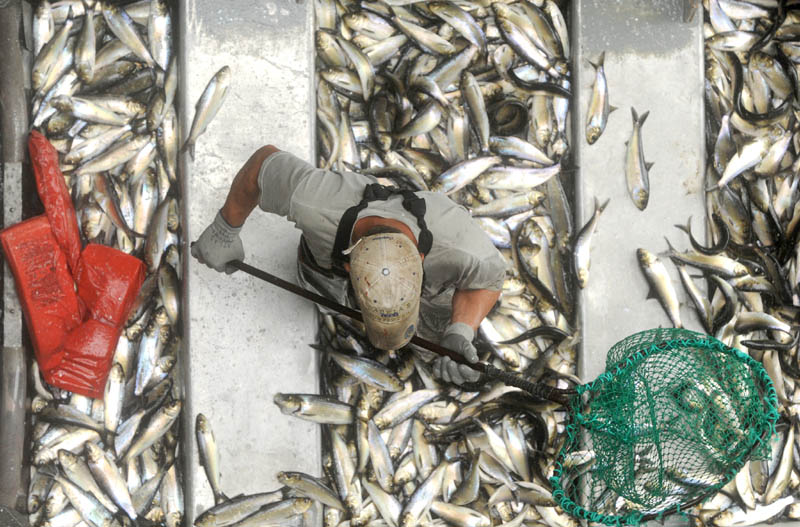BENTON — Alewives are on pace to set a record run in Benton.
On Saturday, Benton residents also will celebrate their relationship with the migratory fish during the second annual Benton Alewife Festival.
Benton Selectman Antoine Morin, festival organizer, said this year’s run is significant because most of the spawning fish hatched from eggs laid in 2009, when the state restored Benton’s traditional harvesting rights.
“It’s kind of like Nemo,” Morin said, referring to an animated movie in which a fish makes an extended journey to rejoin his father. “They’ve returned home.”
For the first three years of their lives, the fish tend to remain at sea, returning to the place of their birth to spawn when they are 4.
This year’s run of fish will be passing by a lot more alewife-themed hoopla than there was in Benton the year they were born and headed out to sea.
The festival, much of which takes place at the Family Fun Park at 269 Neck Road, features free events from 10 a.m. to 9 p.m., including horse-drawn carriage rides, an alewife chowder cookoff, presentations on smoking alewives and other topics, a canoe and kayak race, a floating bonfire on the Sebasticook River, and bus tours to the dam, where the harvesting is ongoing.
At the Benton Falls Dam, a crew of fishermen, contracted with Benton, has been working busily in recent weeks, scooping fish out of the water with nets and selling them for about $60 per crate to lobstermen who prize the alewife as bait.
The traditional alewife harvest in Benton, which dates back at least to the early 1800s, stopped when dams were built downriver. In 1837, when the Edwards Dam was built on the Kennebec River, which the Sebasticook feeds, the annual migration was choked off for more than 160 years.
When the Fort Halifax Dam was removed from Winslow in 2008, the way was cleared for fish to swim upriver to Benton, where an automated lift helps them up and on their way to their spawning grounds. While the fish congregate in the water below the dam, they are easy targets for the harvester’s nets, which is part of the reason for Benton’s celebration.
Each time a crate is sold for $60, Benton collects $20 under its agreement. The more fish run, the more can be harvested, and the more money the town makes.
For three of the past four years, the total number of fish lifted over the dam has ranged between 1.3 million in 2009 to 1.7 million in 2012.
In 2011, there was a bumper run of 2.7 million alewives brought on by favorable conditions, according to Richard Lawrence, Benton’s alewife warden.
The Department of Marine Resources has tracked about 1.3 million fish so far, less than two weeks into a run that could go well into June, according to department biologist Nate Gray.
Most of the fish came during the first week of the run, when the low water levels make for easier harvesting, while the warm temperatures keep the fish moving.
Morin said that in the first week, the alewife harvest yielded a $13,000 check to the town, close to the town’s average take of about $15,000 per year.
The fish were largely absent for a few days in this, the second week, which Gray chalks up to cooler weather, rather than a sign that the run is over.
If the fish return with what meteorologists predict will be higher temperatures ahead, the town is likely to top its record receipts of $19,000.
Morin said the money goes into the town’s general revenue fund and is used to offset property tax increases. The festival is paid for by donations, including significant support from the Sebasticook Regional Land Trust, and the Time and Tide Resource Conservation and Development Area of Maine.
Morin said the festival, which drew about 400 people last year, is a way to build a sense of community among residents, increase traffic to local businesses, and showcase Benton’s appeal to prospective residents.
Gray said that, with the current level of habitat available, the number of alewives that run could range, in perfect conditions, to a theoretical maximum of between 3 and 5 million fish per year.
Jim Wotton, 43, of Friendship, a commercial fisherman who has been harvesting the fish from the Benton Falls dam each year, said he’s never seen so many alewives.
“Barring anything unforeseen, we should shatter last year’s record,” Wotton said.
Gray, a marine biologist with the department, was more cautious about predicting the final number.
“Ask me in August,” he said. “In this business, it pays to be an empiricist, not a theorist.”
Matt Hongoltz-Hetling — 861-9287
mhhetling@centralmaine.com
Send questions/comments to the editors.



Success. Please wait for the page to reload. If the page does not reload within 5 seconds, please refresh the page.
Enter your email and password to access comments.
Hi, to comment on stories you must . This profile is in addition to your subscription and website login.
Already have a commenting profile? .
Invalid username/password.
Please check your email to confirm and complete your registration.
Only subscribers are eligible to post comments. Please subscribe or login first for digital access. Here’s why.
Use the form below to reset your password. When you've submitted your account email, we will send an email with a reset code.